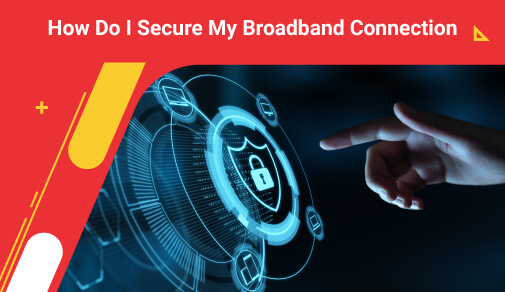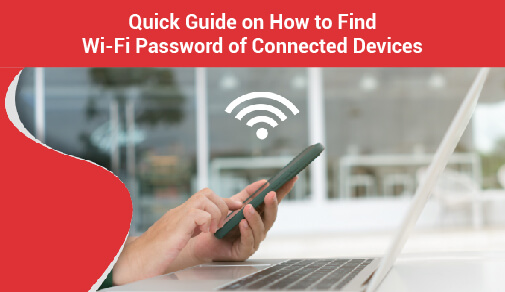Secure Broadband Connection
-
0
-
-
8 minutes

In today's interconnected world, broadband internet has become necessary for most people. People rely heavily on their broadband connection, whether for work, entertainment, or keeping in touch with loved ones.
However, the risk of being vulnerable to cyber threats comes with the convenience of being constantly connected. From identity theft to malicious attacks, an unsecured broadband connection can expose users to many risks with far-reaching tangible and intangible consequences.
So, to keep personal information and data safe, users must take the necessary steps to secure their broadband connection. This blog explores best practices and tips to help individuals protect their broadband connection from potential threats.
Understanding the Risks With Unsecured Broadband Connections and WiFi Networks
Unsecured broadband connections and WiFi networks pose a significant risk to users, as they are vulnerable to hacking, identity theft, and other cyber threats. Anyone with the technical know-how and the right tools can intercept the data transmitted over an unsecured network, including sensitive personal information such as login credentials, credit card details, and private communications.
Users must be aware of the risks associated with unsecured connections and take necessary measures to protect themselves and their online data.
Consequences of an Unsecured Connection
An unsecured internet connection can pose significant risks and consequences to users, friends, and family members. Here are some of the most significant impacts of having an unsecured connection:
Data Interception and Theft
Hackers can easily intercept unsecured connections, allowing them to access sensitive information such as login credentials, credit card numbers, and other private data. This can lead to identity theft, financial losses, and other serious consequences.
Malware Attacks
Unsecured connections can make it easy for hackers to inject malware into the user's device, potentially leading to data loss, system damage, and other cybersecurity issues. As per a report, billions of malware attacks occur yearly, posing a serious user risk.
Breach of Privacy
Without proper security measures, unauthorised parties can easily access and monitor the user's private online activities, such as browsing history, emails, and messages. Breach of privacy can result in significant damage to one's reputation and credibility. The financial implications of such an attack can also be severe.
Financial Loss
Cybercriminals can use stolen personal and financial information for fraud, such as making unauthorised transactions, opening credit accounts, or applying for loans in the user's name. The average data breach cost for a business was about 4.35 million dollars in 2022, which is a significant amount.
Reputation Damage
For businesses, a data breach resulting from an unsecured connection can lead to a loss of customer trust, legal consequences, and negative publicity, potentially damaging the organisation's reputation and credibility. Several individuals and organisations have faced the consequences of such security issues.
Tips to Secure Broadband Connection
Several simple steps can help users protect their broadband connection from potential threats. Here are some of the most effective tips for securing broadband connection and improving router security.
Change the Default Login Credentials
One crucial step in securing the internet connection and improving router security is to change the default login credentials on the router, modem, or any other networking device. Default credentials, such as usernames and passwords, are often publicly available, making it easy for cybercriminals to gain unauthorised access to the network.
By changing these default login credentials, users can significantly reduce the risk of a potential cyber attack. When creating a new password, users should ensure it is strong and unique and combines uppercase and lowercase letters, numbers, and special characters.
Avoid using easily guessable information, such as the user's name, birthdate, or phone number, is also essential. Remember to keep the login credentials safe and secure and change them regularly to maintain the network's security.
Enable WPA3 Encryption
Enabling WiFi Protected Access III (WPA3) encryption is another crucial step in securing the WiFi network. WPA3 is currently the most advanced encryption protocol available for WiFi networks. It encrypts all data transmitted between devices connected to the network, making it much harder for cybercriminals to intercept and steal the data.
When setting up the WiFi network, users should ensure that they enable WPA3 encryption and create a strong, unique passphrase that only they and authorised users can access. It is also important to keep the WiFi password secure and change it regularly to maintain the network's security.
Change the Default SSID
The Service Set Identifier (SSID) is the WiFi network's name, and most routers come with a default SSID, which cybercriminals can easily identify and target. Changing the default SSID to a unique name can make it harder for unauthorised users to identify and connect to the network.
When creating a new SSID, avoiding using personal information or easily guessable words is essential. Using a random combination of letters and numbers can be an effective way to create a unique SSID. Additionally, it is crucial to disable the broadcasting of the SSID, which makes the network invisible to unauthorised users and adds an extra layer of protection.
Disable Remote Management
Remote management allows users to access and configure their routers from anywhere in the world, which can be convenient but also opens up vulnerabilities to cyber-attacks. Cybercriminals can use remote management to gain access to the router and change its settings, potentially leading to unauthorised access to the network.
Disabling remote management ensures that only users physically connected to the network can access and modify the router's settings. To disable remote management, log in to the router's administration panel, and navigate to the remote management settings. Turn off the remote management feature, and save the updated settings.
Keep Firmware Up-To-Date
Keeping the router's firmware up-to-date is also essential to ensure any known security vulnerabilities are patched. Firmware is the software that controls the operation of the router or other networking devices, and manufacturers regularly release updates to fix bugs and address security vulnerabilities.
These updates can include new security features, performance improvements, and bug fixes that can help to protect the network from cyber-attacks. By failing to update the router's firmware, users may be leaving their network open to known security vulnerabilities, which cybercriminals can exploit to gain access to the network.
To update the router's firmware, simply login to the router's administration panel and navigate to the update section. Download and install the latest firmware version, and restart the router. It is recommended to check for firmware updates regularly to ensure the network remains secure.
Use a Firewall
Firewalls are one of the easiest and oldest ways to protect a broadband connection. Firewalls are designed to prevent unauthorised users from accessing the network and can help to prevent criminals from gaining access to the network.
Most routers come with built-in firewalls that provide basic protection, but users can also install additional firewall software on their computers or devices connected to the network. Firewall software is designed to detect suspicious activity and alert users if criminals are targeting their network.
Consider Using a Virtual Private Network (VPN)
A VPN, while primarily used for spoofing IP addresses and bypassing geographic restrictions, can also be used as an additional layer of security for a broadband connection. By encrypting the network traffic, a VPN ensures that the data is secure and can help to prevent criminals from gaining access to sensitive information.
Using a VPN also helps to protect users from malicious websites and other online threats, such as phishing attacks.
As an added layer of security, it is also recommended to enable two-factor authentication on the router, which requires users to provide two pieces of evidence (for example, a password and an authenticator app) when logging in to the router's administration panel.
Additional Security Measures
While the above-mentioned measures are essential for protecting a broadband connection, users can take several additional steps to ensure their networks' security.
Be Wary of Phishing Scams
Phishing scams are one of the most common cyber attacks, and criminals often try to target routers and other networking devices. It is important to be aware of phishing attacks and to avoid clicking on suspicious links or giving away personal information.
Users can read about phishing scams on the Internet and be sure to verify any links or requests for information before responding. They can also implement other measures like email filtering and two-factor authentication to protect their networks from phishing attacks.
Be Aware of Malicious Websites
Another way that criminals can gain access to a network is by redirecting users to malicious websites. Malicious websites contain malware and other malicious code that can be used to compromise a network.
To protect against malicious websites, users can install reputable antivirus software, keep their browser and operating system up-to-date, avoid clicking suspicious links, and use caution when entering personal information on unfamiliar sites.
Educate Family Members or Roommates About Cybersecurity Best Practices
Finally, educating family members or roommates about cybersecurity best practices can also help to protect a network. Family members and roommates should know the importance of protecting a network. They should be instructed on identifying suspicious activity and protecting their devices from cyber threats.
Start by discussing the importance of strong passwords, avoiding suspicious links and attachments, and keeping devices and software up-to-date. Encourage them to use two-factor authentication and to be cautious when sharing personal information online.
Finally, emphasise the importance of regular backups and explain the potential consequences of a security breach.
Following these simple steps, users ensure their broadband connection is safe and secure. From updating the router's firmware to enabling two-factor authentication, these measures will help to protect the network from criminals and other security threats.
Conclusion
Securing the broadband connection is crucial to protecting personal and business data from cyber attacks. Users can significantly reduce the risk of a potential cyber attack by taking the necessary steps, such as the ones mentioned above.
It is also essential to be vigilant and aware of potential security threats and to educate oneself and family members on staying safe online. By implementing these best practices and adopting a proactive approach to network security, users can maintain the integrity and privacy of their data and ensure that their internet connection remains secure.
ACT Fibernet's services offer a skilled facility, advanced WiFi equipment, 24x7 customer support, and optimised network settings. Contact ACT Corp now to experience unpaired internet speeds and enjoy reliable, high-speed connectivity throughout the location.







